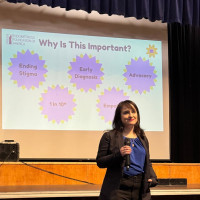Conference - 2011: Endometriosis Foundation of America
– Marta Meana, PhD
Heather Guidone
And in keeping with the thread of “Let’s Talk about Sex, Seriously” I would like to introduce Dr. Marta Meana who is a professor of Clinical Psychology joining us today from the University of Nevada. Dr. Meana is one of the foremost researchers in this area and she is going to talk to us about taking sex seriously and also about the psychosocial correlates of dysparunia. Thank you.
Marta Meana, PhD
Thank you very much for the invitation to be here today, talking about this very important topic. I am going to address two related topics; why surgery may not be enough to deal with the problem of dysparunia, and also why we should take this problem very, very seriously. I obviously hardly need to remind this audience that up to 70 percent of women with endometriosis have pain symptoms. Most notably dysmenorrhea, non-cyclic pelvic pain and/or deep dysparunia, which as you know is recurrent pain with or after intercourse, experienced either deep in the vaginal canal or in the abdomen.
Let us take a closer look at the prevalence of pain and endometriosis. This is a very large sample and it is biased because it is a self-report sample of women in a registry of an endometriosis organization. But as you can see the most common reported pain by over 90 percent of women was pain associated with the menstrual period. The second was discomfort associated with bloating at over 80 percent followed closely by painful bowel symptoms and other gastrointestinal discomfort. You can see in this very large sample just over 60 percent of respondents reported pain during or after sexual intercourse. Headaches were also quite prevalent and just over 30 percent of women reported pain with urination. In patients who end up undergoing surgery the prevalence of dysparunia may actually be even higher with estimates in the literature ranging from 60 to 79 percent. Endometriosis that involves uterosacral ligaments may be the worst case scenario, with these women reporting the highest intensity of pain and the most severe impairments in overall sexual function.
Now let us briefly turn to surgery outcomes in terms of intercourse pain. If we first look at non-randomized non-placebo controlled studies what we fund is that conservative surgery is reported to be quite successful at targeting dysparunia. Seventy to eighty percent of women in these studies report significant improvement with anywhere from 2 to 5 point decreases in visual analogue pain scales. If we turn to randomized and blinded control trials surgery still boasts impressive outcomes. In laparoscopic laser surgery 62 percent reported improvement in pain compared to 23 percent in placebo groups. In laparoscopic excision 80 percent of patients have reported improvement in pain compared to 32 percent in the placebo group. One study showed that when presacral neurectomy was added to an already performed laparoscopic excision, only a slight decrease in pain was found over and above the original surgery. When uterosacral neurectomy was added to an already performed laparoscopic procedure there appeared to be no added benefits. And finally, hysterectomy which is obviously an option only for women who are not interested in future childbearing there was a significant improvement in pain symptoms despite the fact that there are some people who are starting to say that maybe those results are not as good as they look if you ask the right questions.
Bottom line, surgery really does quite well in alleviating symptoms of dysparunia. So you might probably be asking yourselves why part of this talk is entitled “Why Surgery is not or may not be enough”. What I would like you to do today is to consider the following general concerns. Improvement is wonderful but when it comes to sex even a bit of pain can be a deal breaker. And that is because unlike other activities of daily living the primary purpose of sex is pleasure. Think about it. If you have lower back pain that interferes with you sitting at your computer any improvement in that pain is going to be a welcome relief. But sitting at your computer does not generally have pleasure as its aim although I guess that depends on what you are doing at your computer. Basically what I am trying to say is when an activity needs to be done anything that makes it easier is going to be welcome. But sex is a whole other story. You do not have to have sex. You do it because it is pleasurable. You do it to lose yourself in the joys of your body and those of your partner. So, even a relatively small amount of pain during sex can completely shatter that aim. Even if the surgery halves the pain score for any given woman, which we would consider a huge success that might still mean she cannot or will not want to have sex. Unwanted pain is just not compatible with desire, or arousal, or orgasm. There is no room for unwanted pain in sex, even a low level of it. To many women this is going to feel like an all or nothing affair. If it hurts at all why do it at all, other than of course to please a partner, which leads to a host of other problems that I will be touching on later.
Generally speaking we can, and should be, proud of being able to improve pain with our surgical procedures but keep in mind that when it comes to sex, improvements may simply be not enough. Then there is the fact that even in studies with the most impressive outcomes upwards of 20 percent of women report no improvement in dysparunia and that is a significant number. The problem some of these women may be experiencing relates to straight Pavlovian conditioning. I am a psychologist so I look at things this way. If dysparunia has been experienced for a relatively long period of time as we know it has in many cases, then what you can have happen is a classical conditioning process that starts to take hold, such that sex is paired with pain repeatedly, and over time sex becomes a conditioned stimulus such that it primes the woman for pain, so the two have to some extent become indistinguishable. In this, and other ways, the factors that initiated the pain, such as tissue damage or adhesions, implants or infections, or any other bodily insults are not necessarily the factors that maintain the pain. That is a very important distinction. So, you could find yourself in a situation where you can get rid of the etiologic source and still be left with the symptom.
Outside of this classical conditioning paradigm there are also other factors that can maintain the pain even after implants have been excised. First of all, I do not think we talk enough about neuropathic pain. Dr Gomel spoke about this just briefly a few minutes ago. Neuropathic pain can set in if damage to peripheral or central nerve fibres has occurred over time. This damage can result in these intermittent persistent neuronal discharges that set up abnormal neural circuits at the spinal cord level or at the central level that results in these signals keep on being abnormally fired to the central processing and perception centers. This may lead to a persistent perception of pain long after the original stimulus has been removed. Another factor that can maintain the pain is the development of hypertonis in the genitals such that muscle tension and contraction is high and makes penetration painful. This hypertonic response can have developed after years of bracing yourself for pain during intercourse but in some cases it may actually have preceded the development of endometriosis, and this is a very important thing to assess for. Given the repeated experience of pain with intercourse and understandable lack of desire for sex this can also lead to arousal deficits. If there is not sufficient arousal there are likely to be impairments in lubrication and in the, this is very important, vaginal tenting that facilitates penetration. Even in women without endometriosis a lack of lubrication and tenting can result in uncomfortable or painful intercourse. In addition now to the fact that the pain may persist for reasons other than what initiated it there is also a question that needs our attention and that is, how adequate an outcome measure is self-reported intercourse pain? I would argue that if we are to really care about restoring sexual function in the lives of women with endometriosis pain relief may not be a sufficient outcome variable in our research. Pain with intercourse triggers or can trigger a cascade of negative sexual, psychological and relation sequelae that do not just go away when the pain does. We need a more systemic consideration, there is a theme building here on the biological level, on the social level, on the psychological level and that is to look at this in a holistic way. Longstanding pain with intercourse exists within a system. Over time the pain may have influenced how the woman feels about sex in general, about herself and even about romantic relationships, so that even complete relief of pain in some cases cannot heal the damage done to numerous dimensions in the lives of many women. A number of treatment outcome studies for dysparunia in general, not just due to endometriosis, have shown significant pain reduction but no improvements in sexual frequency and satisfaction. That I think is not good enough. Pain reduction without a concomitant improvement in overall sexual function I think is just not a sufficiently ambitious treatment goal.
Now I would like to move on and I do want to give a shout out to Ferrero and colleagues who have actually looked at sexual function, not just in terms of pain and we need a lot more research like that.
I want to move on to the reasons why we all really need to care about this. There has been a very longstanding tendency both in medicine and in my own field of clinical psychology to relegate sex to some kind of second order concern. It is hard to know why that is but I suspect it emanates from our societal discomfort with issues of sexuality, pretty much cross-culturally. However, when we ask individuals across cultures in large, large surveys how important sexuality is to their quality of life, it is consistently ranked very high, usually right after satisfaction with personal relationships and general health. And as Lone addressed, the World Health Organization now officially considers sexual health to be a crucial aspect of overall health and well being. The societal burden of dysparunia is also believed to be very high. It is associated with complex conditions that have high associated health care costs, such as interstitial cystitis, irritable bowel syndrome, pelvic inflammatory disease, chronic pelvic pain and of course endometriosis. Appropriate treatments for these conditions as we all in this room well know, are not often immediately identifiable. So often what happens is the woman who experiences the pain with intercourse is understandably going to doctor shop. She is trying to find a solution. She is likely to engage in uncoordinated, multiple attempts at treatment. She is also likely to lose patience with strategies that do not show immediate effects and as we know, very few strategies show immediate effects. Dysparunia is also likely a factor in infidelity, relationship dissatisfaction and even in divorce. Marriages in which sexual satisfaction is low do not fare well. This toll on relationships represents really both an individual and a societal burden. This is a big deal. We need to change attitudes that seek to diminish the importance of sexual health. When I was still a graduate student I was at a conference presenting my preliminary data that I had done on a large sample of women with dysparunia and one of the attendees, a doctor, came up to me as I was standing next to my poster and kind of smirking said, “Well you know dysparunia is better than no parunia at all”. And that is really what the attitude was for a very long time. So I would like to say, “No it isn’t”. That statement is so not true. We know that women who suffer from dysparunia have much lower frequency of intercourse; they tend to avoid all sorts of sexual activity, even non-penetrative activity. They report lower sexual desire with a significant number of them saying that they do not have any desire for sexual activity at all. They have difficulties with both subjective and physical arousal. They have more difficulty reaching orgasm with any kind of stimulation, not just with intercourse. And in a significant minority, even arousal and orgasm itself can be painful.
In terms of psychological well-being the research on dysparunia has shown higher levels of anxiety, depression, interpersonal sensitivity, fear of pain, self-esteem problems and more negative attitudes, understandably, toward sexuality. For decades health professionals believed that many cases of dysparunia were in fact caused by psychological problems by psychosexual problems. It seems much more intuitive to think that depression and anxiety might be the consequences of pain but that view persists to this day. I still hear stories from women who have been dismissed as having psychological problems when they present to a doctor with sexual pain, and I am sure that doesn’t happen with the people in this room but it still happens out there. Through our research efforts today we know that the link between our psychological difficulties and pain is complicated, although it is fairly evident that in most cases mood disturbances are consequences of dysparunia. We also know that pain perception, pain thresholds and pain tolerance are also affected by psychological states. The pain may have caused the mood disturbance but soon thereafter they develop this reciprocal relationship. The research that we do also indicates that certain cognitive styles are associated with longstanding sexual pain. In particular, hypervigilance to somatic sensations or symptoms of any kind appears to be common in this population. Another common cognitive style is the tendency to catastrophize the experience of pain, such that it is always perceived as intense without modulation. It is often interpreted to be indicative of serious tissue damage and even life threatening conditions. Again, as in the case of mood disturbances it is likely that the experience of pain created the hypervigilance and pain catastrophization but once that sets in these cognitive styles will on top of it magnify the already existing pain. In terms of relationships, clearly pain with intercourse has a significant impact. It is very hard actually to track down the reasons why relationships break up because each person will conceal a different reason so it is actually hard to track the reasons for divorce. Also, individuals tend to privilege one reason over another and nobody wants to say that sex is the reason they broke up. It feels superficial to say that. But we do have enough research to know that sexual difficulties feature prominently in divorce, although this comparative data is hard to come by.
What happens is in therapy, the kind of work that I do clinically, we see intact couples because who goes to seek help for dysparunia? People who are partnered and trying to have sex with a partner and cannot. Let me tell you a little bit about what we see in these intact couples. We see in both partners anger emanating resentment from a lack of understanding why their partners avoid sex. Since the pain is often not attached to a specific and treatable, or it feels that way, diagnosis doubts start to arise about whether there is a physical reason why the woman does not want to have sex. Maybe she just does not enjoy it. The women tend to be angry both at themselves and at their partners; at themselves because they feel abnormal and sometimes internalize these messages about the pain being self-generated. Also you get resentment toward partners from a perceived pressure to have to engage in this painful activity. It is common for them to perceive their partners as lacking in understanding. So you see how easily this would become complicated. We also see a lot of insecurities in these couples, men often thinking that their partners may be hiding a lack of attraction for them and both the men and the women in these couples become concerned that the partner will seek sexual satisfaction elsewhere or that they will simply leave. Perhaps the most common thing that we see here is what I call disengagement. When couples have pain with intercourse they have a tendency to stop having sex altogether, any kind of sex, even though there is a whole repertoire of activities they could engage in that are not painful. When the sex drops off so does the non-sexual affection, which leads to less contact and anyway, before you know it, what you have got is a couple who have functionally just become roommates. They put a distance between them so they do not have to be reminded or confronted of the difficulty they have. There is also some interesting research showing the direct links between relationship characteristics and the experience of dysparunic pain. For example, general dyadic adjustment, how well a couple gets along, is a relatively strong predictor of pain intensity. The more well adjusted the couple, the lower the pain ratings. Of course this could mean that happier couples are happier because they have less pain or it could mean that level of happiness in a relationship actually also has an impact on pain experience. Another interesting finding is partner solicitousness. This is the extent to which a partner is very attentive to the pain, and although you might think that would be a good thing, and it certainly seems like a nice thing to do, we also find that in these couples when the partner is overly attentive to the pain that the pain ratings are also higher.
Let me conclude here, having reviewed some the reasons why surgery may not be enough and catalogue the ways in which dysparunia affects women on a number of different dimensions, and their partners, what can we do, right? That is what we all want to figure out here. I would like to suggest that we need to take a holistic and systemic approach to the symptoms of endometriosis and their functional interference in women’s lives. Most of us have been trained in the scientific method to great effect. As researchers we focus on isolating symptoms and targeting them with sequential interventions so that we can pinpoint what works well on what. That method obviously has some very big strengths but I think clinical practice, while informed by science, requires a more expansive approach until the science catches up. In the case of dysparunia I believe the ideal to be a concurrent multi-disciplinary treatment model wherein the expertise of a team of health care professionals who communicate with each other is brought to bear on the problem. Because when you shuffle the patient from one discipline to another as a strategy, this appears to fail and we are potentially missing out on the interactive effect of approaching the problem from different angles simultaneously. So you want MDs, and surgeons and physical therapists who specialize in pelvic floor dysfunction, which I cannot tell you how useful they have been in my clinical cases, and then of course mental health professionals with expertise in sex and couples’ therapy. This can be a powerful treatment team. Not every case is going to require all components but all should at least be considered and I realize this is an ideal model with significant barriers, the most obvious one being cost, not all women will be a position financially to avail themselves of all of these services. On the other hand I would say to you if you look at the treatment history of women with dysparunia, an awful lot of money has been spent on this kind of sequential uncoordinated treatment approach. But even if there is only one health care professional available, the woman is not in a metropolitan center and that is all that she has got, I think that if that health care professional adheres to the spirit of this model, to an awareness of the many dimensions on which endometriosis is lived we can go a very long way to directing the patient to possible alternate care. We have an unprecedented historically array of self-help resources.
Let us not dismiss the potential contributions of every discipline that is relevant. We each come at this with a bias obviously, and each woman is going to be different in terms of what differentially affects her pain. But I would say to you that bias is good if you are all in the same room together! I should be privileging some things over others and doctors should be privileging things like infiltration depth instead of relationships. But if we come together and let all these biases collide with every case I cannot see how patient outcomes would not benefit from it.
Thank you very much.










